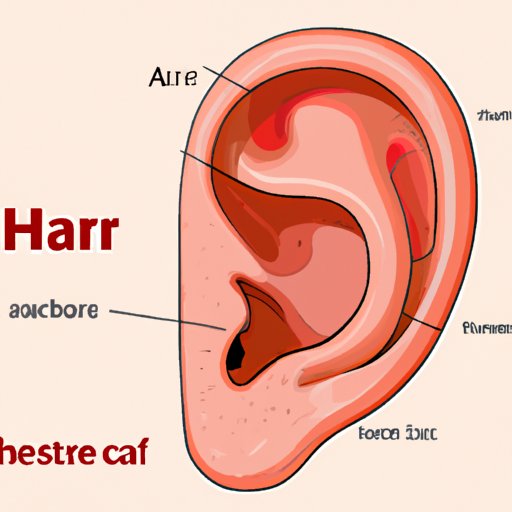Introduction
The human ear is an intricate and complex organ that plays a vital role in our ability to hear. It is composed of three distinct parts – the outer ear, the middle ear, and the inner ear – each with its own unique structure and function. This article will explore how the ear works by examining the anatomy and physiology of the ear, how sound is processed by the ear, and the role of the auditory nerve in hearing. We will also discuss the impact of ear-related disorders on hearing.

Anatomy and Physiology of the Ear
The ear is divided into three main parts – the outer ear, the middle ear, and the inner ear. Each part has its own unique structure and function that contributes to our ability to hear.
Outer Ear
The outer ear consists of the pinna, or auricle, and the external auditory canal. The pinna is the visible portion of the ear and is responsible for collecting sound waves and funneling them into the external auditory canal. The external auditory canal is a tube-like structure that leads to the eardrum.
Middle Ear
The middle ear is located behind the eardrum and consists of three small bones known as the ossicles. These bones – the malleus, incus, and stapes – are connected to one another and act like a lever system to amplify sound waves and transmit them to the inner ear.
Inner Ear
The inner ear is made up of the cochlea, which is a snail-shaped structure filled with fluid, and the semicircular canals, which are responsible for maintaining balance. The cochlea is the primary organ responsible for hearing and is composed of thousands of tiny hair cells that pick up sound waves and convert them into electrical signals. These electrical signals are then sent to the brain through the auditory nerve.

How the Ear Processes Sound
Sound is produced when vibrations cause particles in the air to move. These vibrations travel in the form of sound waves and enter the ear through the pinna. The sound waves then travel through the external auditory canal and strike the eardrum, causing it to vibrate.
The Role of the Eardrum
The vibrations of the eardrum cause the ossicles to move, amplifying the sound waves and transmitting them to the inner ear. According to a study published in The Journal of Experimental Biology, “The ossicles act as a lever system, increasing the force applied to the oval window of the cochlea, thus enabling greater transmission of sound energy.”
The Role of the Ossicles
The ossicles are made up of three small bones – the malleus, incus, and stapes. They are connected to one another and act like a lever system to amplify sound waves and transmit them to the inner ear.
The Role of the Cochlea
Once the sound waves reach the inner ear, they enter the cochlea, a spiral-shaped structure filled with fluid. The cochlea is composed of thousands of tiny hair cells that are sensitive to sound vibrations. As the sound waves travel through the cochlea, they cause the hair cells to vibrate, producing electrical signals that are sent to the brain through the auditory nerve.
The Role of the Auditory Nerve in Hearing
The auditory nerve is a bundle of nerve fibers that transmits sound signals from the inner ear to the brain. The auditory nerve is responsible for processing sound signals and translating them into meaningful information.
Overview of the Auditory Nerve
The auditory nerve is composed of two main parts – the cochlear division and the vestibular division. The cochlear division is responsible for transmitting sound signals from the cochlea to the brain, while the vestibular division is responsible for transmitting signals related to balance and spatial orientation.
The Role of the Auditory Nerve in Processing Sound
The auditory nerve is responsible for processing sound signals and translating them into meaningful information. According to a study published in Nature Neuroscience, “The auditory nerve is capable of encoding complex sounds, including speech, music, and other environmental sounds.”
Effects of Ear-Related Disorders on Hearing
Ear-related disorders can have a significant impact on hearing. Some of the most common ear-related disorders include otitis media, sensorineural hearing loss, and Meniere’s disease.
Types of Ear-Related Disorders
Otitis media is an infection of the middle ear that can lead to hearing loss. Sensorineural hearing loss is caused by damage to the inner ear and can result in difficulty hearing high-frequency sounds. Meniere’s disease is an inner ear disorder that can cause vertigo, tinnitus, and hearing loss.
Impact of Ear-Related Disorders on Hearing
Ear-related disorders can have a significant impact on hearing. Sensorineural hearing loss can make it difficult to hear high-frequency sounds, while otitis media can lead to temporary hearing loss. Meniere’s disease can cause permanent hearing loss in some cases.
Conclusion
The human ear is a complex and delicate organ that is essential for our sense of hearing. It is composed of three distinct parts – the outer ear, the middle ear, and the inner ear – each with its own unique structure and function. The ear processes sound using the eardrum, ossicles, and cochlea, and the auditory nerve is responsible for transmitting sound signals to the brain. Ear-related disorders can have a significant impact on hearing, so it is important to be aware of the signs and symptoms and seek treatment if necessary.
(Note: Is this article not meeting your expectations? Do you have knowledge or insights to share? Unlock new opportunities and expand your reach by joining our authors team. Click Registration to join us and share your expertise with our readers.)
